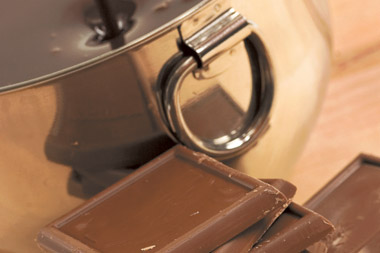The latest buzz about chocolate says bitter is better; dark chocolate has fewer calories than other varieties, and packs a powerful antioxidant punch. In fact, scientific studies from The American Journal of Hypertension tout the Valentine’s Day staple (in moderation) as a heart-healthy food that lowers unhealthy LDL cholesterol and prevents plaque from building up in your arteries.
Chef Marcel Desaulniers, author of the James Beard award-winning cookbook Death By Chocolate, believes that in addition to its health benefits, dark chocolate’s intense, bitter flavor provides a deeper, longer-lasting satisfaction in baking. A little dark chocolate has more intense flavor than milk, white or semi-sweet, so you need less to achieve a robust flavor. Chef Desaulniers shares his philosophy on chocolate, and provides tips for selecting the world’s finest.
What makes dark chocolate different from other varieties?
Dark chocolate, usually marketed as bittersweet chocolate, has less sugar and more cocoa liquor (unsweetened chocolate) than semisweet chocolate. Unlike dark, semisweet and milk chocolates, white chocolate does not contain chocolate liquor (made by grinding cocoa beans into a liquid state). Instead it uses only the fat component of the cocoa bean (not the liquor). I use semisweet almost exclusively, with the occasional white chocolate recipe thrown in. I have only used milk chocolate once and that was for drizzling over a peach upside down cake.
What should consumers look for when buying chocolate?
Real chocolate should include only the following ingredients on the label: chocolate, sugar, cocoa butter, soy lecithin (an emulsifier that allows chocolate to maintain a smooth texture when melted), and vanilla. Surprisingly, some manufacturers have a history of manipulating chocolate, using ingredients like soy flour to cut costs. Even reputable manufacturers market “chocolate-flavored” products that omit cocoa butter, which for me is the soul of chocolate. Cocoa butter melts at a temperature that’s slightly lower than body temperature, so the more cocoa butter in a piece of chocolate, the more rapidly it will melt in your mouth.
How do you select the chocolate for a particular dessert?
I use Baker’s brand to test recipes because it was always in my mom’s cupboard, it’s accessible, and it provides a delicious chocolate flavor in baking recipes. You can up the ante by using more expensive grades of imported dark chocolates that deliver a smooth but intense flavor. For a more intricate flavor in truffles, for instance, I’ll layer chocolates, adding chocolate liquor in conjunction with the semisweet.
In your opinion, which region of the world produces the best chocolate?
The Swiss, French, and even the Brits have garnered many accolades over the years for excellent chocolate, often because the great producers go the extra nine yards in conching (a process of constantly moving melted chocolate until it achieves an incredibly smooth texture). But in terms of the beans, much of the world’s cocoa comes from South and Central America and Africa, since warm temperatures and rain are necessary for quality fruit.
What is your favorite quick-fix chocolate dessert?
I like to make chocolate-drenched pear halves. After melting your favorite dark chocolate, dip about one inch of each half into the melted chocolate. Place the dipped pear halves onto a parchment paper-lined baking sheet and refrigerate until hardened.



